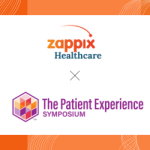Where Empathy Meets Innovation
The 2025 Patient Experience Symposium in Boston (October 6-8th) revealed a clear transformation in healthcare’s collective mindset. What once centered on measuring patient experience has evolved into nurturing relationships. Across sessions and panels, healthcare leaders spoke not just of metrics but of meaning, shifting focus from scores to stories and from process to people.
This year’s conversations marked a turning point. Empathy, equity, and intelligent technology are no longer separate priorities; they’re partners in redefining care. The next chapter of healthcare isn’t about replacing the human touch. It’s about extending it digitally.
Orchestrating Experience: Leadership, Systems, and Scale
One of the most resonant metaphors from the symposium compared leadership to orchestration, a conductor aligning teams, instruments, and timing toward harmony. Patient experience, it turns out, is rarely a solo performance.
From a reminder text to a recovery call, every touchpoint contributes a note to the patient journey. When played in sync, these interactions form a seamless composition of care. True leadership, attendees agreed, is about designing systems that can scale that harmony so no patient feels like background noise in their own story.
Human-Centered AI: Technology as an Act of Care
Sessions from Stanford Health Care reframed artificial intelligence in a deeply human light, not as a replacement for empathy but as a way to amplify it.
When organizations view algorithms as assistants rather than replacements, AI becomes a partner in compassion. It can surface insights, flag urgent needs, or handle routine tasks, freeing clinicians to spend their time where it matters most: connecting with patients.
AI in patient experience is most powerful when it listens before it speaks.
Listening Differently: From Surveys to Stories to Signals
One statistic captured the audience’s attention. Narrative feedback produced 50% more actionable insight than surveys alone. The message was simple. Patients don’t want to be measured; they want to be heard.
This shift from static metrics to dynamic listening reflects healthcare’s growing understanding that every patient interaction, whether a message, a gesture, or a click, carries emotional and behavioral data.
Digital signals are becoming the new patient narratives. In them lies a new language of empathy that healthcare organizations are just beginning to translate.
Health Equity and Trust: Extending Dignity Across Every Channel
Equity and trust ran as quiet but persistent themes throughout the symposium. Many speakers emphasized that compassion must include accessibility, inclusion, and respect for the social determinants of health.
Programs like Feeding Our Own demonstrated how care extends far beyond clinical walls, and digital systems should follow that example. Instead of requiring patients to navigate complex portals or download multiple apps, technology can meet people where they are, on their phones, in their language, at their pace.
Equity in care must include digital equity. Every message, every screen, every option matters.
Leading with Love: The Architecture of Empathy
Perhaps the most striking theme was that love and kindness can be operationalized. Leadership frameworks like the INTEGRATE model illustrated how empathy can shape systems, policies, and even workflows.
Leading with love isn’t just a bedside principle; it’s a design philosophy. From clinical protocols to interface layouts, every element of the patient experience can be an act of respect and reassurance.
The Zappix Perspective: Compassion, Connected
The symposium underscored a shared vision, a healthcare system where empathy, equity, and efficiency are not competing goals but interlocking pillars.
Zappix helps bring that vision to life by automating key points of the patient journey, from reminders and scheduling to digital self-service and intelligent outreach. By orchestrating engagement across channels and freeing staff from repetitive work, Zappix enables providers to focus on what matters most: human connection.
Automation becomes the quiet engine behind compassion, ensuring that every patient receives timely, personalized, and consistent care without adding to staff burden.
Technology, when designed with empathy, doesn’t distance. It delivers.
When empathy becomes infrastructure, every moment in the patient journey can become an act of care.





